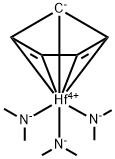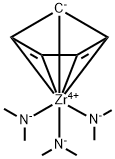DICARBONYLCYCLOPENTADIENYLCOBALT
Synonym(s):Cobalt dicarbonyl cyclopentadiene;CpCo(CO)2;Cyclopentadienyl cobalt(I) dicarbonyl;Cyclopentadienylcobalt dicarbonyl;Cyclopentadienyldicarbonylcobalt
- CAS NO.:12078-25-0
- Empirical Formula: C7H5CoO25*
- Molecular Weight: 180.05
- MDL number: MFCD00009589
- EINECS: 235-139-8
- SAFETY DATA SHEET (SDS)
- Update Date: 2023-04-23 13:52:06

What is DICARBONYLCYCLOPENTADIENYLCOBALT?
Chemical properties
dark red to brown liquid
The Uses of DICARBONYLCYCLOPENTADIENYLCOBALT
Dicarbonylcyclopentadienylcobalt Catalyst for the cyclotrimerization of alkynes. It mediates the [2+2+2]-cyclization of allenediynes to tricyclic systems. catalyzes the formation of pyridines from a mixture of alkynes and nitriles.
What are the applications of Application
Dicarbonylcyclopentadienyl cobalt(I) is a cyclotrimerization of alkyne catalyst
Purification Methods
Best distilled in an atmosphere of CO in a vacuum. The red brown liquid decomposes slightly on distillation even in a vacuum to liberate some CO. Operations should be performed in an efficient fume cupboard. It is soluble in organic solvents and stable in air but decomposes slowly in sunlight and rapidly under UV. [Piper et al. J Inorg Nucl Chem 1 165 1955, Beilstein 16 IV 1827.] TOXIC.
Properties of DICARBONYLCYCLOPENTADIENYLCOBALT
| Melting point: | -22 °C |
| Boiling point: | 139-140 °C710 mm Hg(lit.) |
| Density | 1.35 |
| refractive index | 1.599-1.602 |
| Flash point: | 80 °F |
| storage temp. | 2-8°C |
| form | liquid |
| color | dark red |
| Specific Gravity | 1.35 |
| Water Solubility | Insoluble in water. Soluble in common organic solvents. |
| Sensitive | Air Sensitive |
| NIST Chemistry Reference | Cobalt, dicarbonyl(«eta»5-2,4-cyclopentadien-1-yl)-(12078-25-0) |
Safety information for DICARBONYLCYCLOPENTADIENYLCOBALT
| Signal word | Danger |
| Pictogram(s) |
 Flame Flammables GHS02  Skull and Crossbones Acute Toxicity GHS06  Health Hazard GHS08 |
| GHS Hazard Statements |
H226:Flammable liquids H334:Sensitisation, respiratory H341:Germ cell mutagenicity H351:Carcinogenicity |
| Precautionary Statement Codes |
P202:Do not handle until all safety precautions have been read and understood. P210:Keep away from heat/sparks/open flames/hot surfaces. — No smoking. P280:Wear protective gloves/protective clothing/eye protection/face protection. P301+P310:IF SWALLOWED: Immediately call a POISON CENTER or doctor/physician. P303+P361+P353:IF ON SKIN (or hair): Remove/Take off Immediately all contaminated clothing. Rinse SKIN with water/shower. |
Computed Descriptors for DICARBONYLCYCLOPENTADIENYLCOBALT
New Products
(S)-3-Aminobutanenitrile hydrochloride 4-Methylphenylacetic acid N-Boc-D-alaninol N-BOC-D/L-ALANINOL Tert-butyl bis(2-chloroethyl)carbamate 3-Morpholino-1-(4-nitrophenyl)-5,6-dihydropyridin- 2(1H)-one Furan-2,5-Dicarboxylic Acid Tropic acid 1-Bromo-3,5-Di-Tert-Butylbenzene S-2-CHLORO PROPIONIC ACID ETHYL ISOCYANOACETATE 2-Bromo-1,3-Bis(Dimethylamino)Trimethinium Hexafluorophosphate 4-IODO BENZOIC ACID 3-NITRO-2-METHYL ANILINE 1-(2,4-DICHLOROPHENYL) ETHANAMINE (2-Hydroxyphenyl)acetonitrile 4-Bromopyrazole 2-(Cyanocyclohexyl)acetic acid 4-methoxy-3,5-dinitropyridine 1-(4-(aminomethyl)benzyl)urea hydrochloride 2-aminopropyl benzoate hydrochloride diethyl 2-(2-((tertbutoxycarbonyl)amino) ethyl)malonate tert-butyl 4- (ureidomethyl)benzylcarbamate Ethyl-2-chloro((4-methoxyphenyl)hydrazono)acetateRelated products of tetrahydrofuran






You may like
-
 Dicarbonylcyclopentadienylcobalt CAS 12078-25-0View Details
Dicarbonylcyclopentadienylcobalt CAS 12078-25-0View Details
12078-25-0 -
 Dicarbonylcyclopentadienylcobalt CAS 12078-25-0View Details
Dicarbonylcyclopentadienylcobalt CAS 12078-25-0View Details
12078-25-0 -
 Dicarbonylcyclopentadienylcobalt(I) CAS 12078-25-0View Details
Dicarbonylcyclopentadienylcobalt(I) CAS 12078-25-0View Details
12078-25-0 -
 Dicarbonylcyclopentadienyl cobalt(I) CAS 12078-25-0View Details
Dicarbonylcyclopentadienyl cobalt(I) CAS 12078-25-0View Details
12078-25-0 -
 1975-50-4 98%View Details
1975-50-4 98%View Details
1975-50-4 -
 2-HYDROXY BENZYL ALCOHOL 98%View Details
2-HYDROXY BENZYL ALCOHOL 98%View Details
90-01-7 -
 14714-50-2 (2-Hydroxyphenyl)acetonitrile 98+View Details
14714-50-2 (2-Hydroxyphenyl)acetonitrile 98+View Details
14714-50-2 -
 118753-70-1 98+View Details
118753-70-1 98+View Details
118753-70-1
Statement: All products displayed on this website are only used for non medical purposes such as industrial applications or scientific research, and cannot be used for clinical diagnosis or treatment of humans or animals. They are not medicinal or edible.